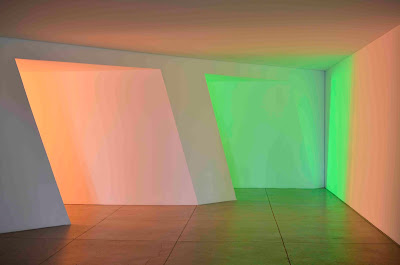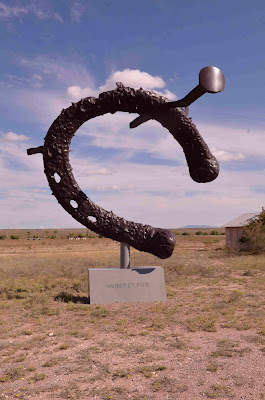Our RV friends Paul and Carol have been extolling the art of Chinati since we first met. We have finally made it to Marfa in Big Bend Country. They were ever so right. We had an amazing day filled with wonderful and unique art.
Chinati, named for the nearby mountains, is on the site of WWII Fort D. A. Russell, abandoned in 1946. Donald Judd, an acclaimed NYC artist at the time, was most unhappy with the way his art was presented and sought to find a more appropriate venue. He went to Texas and bought the fort and its badly dilapidated buildings. Repairing the buildings is an ongoing operation.
Believing in “the purity of art and its value to society,” Judd established Chinati to preserve and present large-scale installations. He invited his artists friends to join in displaying their art in Marfa. Though Judd died suddenly 1994, the two foundations he set up continue to follow his creed.
We took a six hour tour (two hour lunch break) of much of the 340 acres. Our docent was outstanding in giving the history of Chinati and information on the various permanent and temporary collections. The photographs that follow give only a hint at the dimensions of the work at Chinati. Most are huge. Judd created 100 milled aluminum boxes each weighing one ton. He created in “seriality,” the concept of repetition with slight alterations. This is easier to see than put into words. Most of his fellow artists used the same concept.
This is one of the two buildings housing these works.
Charlotte Posenenske: German artist created with cardboard boxes that could be rearranged to suit the buyer’s taste and colored boxes that could also be rearranged.
Ukranian artist Kabakov: The sign over the door to the exhibit translates to “good welcome.”
Items are scattered on the floor looking like a messy schoolroom and representing the failure of USSR.
Sea Lava Circle
The Arena, a gymnasium when the fort was in operation, is used for foundation events. The
wooden tables and chairs are uncomfortable and you can hear tin roof singing as the wind blows or the sun heats it up.
David Rabinowitz: Elliptical Plane in 3 Masses and 4 Scales, a floor piece 70 x 71 inches.
Judd’s wall pieces
In town of Marfa the old Wool and Mohair building houses temporary exhibits, also a part of the Judd Foudation. Texas Pieces by John Chamberlain seemed made of old cars.
Gondola William Carlos Williams
Jerry and Anna Lee enjoyed an excellent lunch at Capri Café, a recommendation of the docent.
This road runner greeted us upon our return.
Our afternoon tour continued with visits to more buildings. Six buildings contain the florescent light installations by Dan Flavin, a good friend of Judd.
Animo et Fide, meaning Spirited and Faithful is a tribute to Louis, the last horse to remain on the base. It is a work by Claes Oldenburg. The horse was given a Hale and Farewell and buried on the grounds.
A soldier assigned to the fort drew cartoon characters on his barrack walls. Judd liked them and had them preserved.
John Wesley Flavin, another good friend of Judd, donated some of his works to be shown at Chinati. The one of Louis Brandeis caught our eye right away.
The artist has himself in an interesting frame.
Ronny Horn: These copper shapes are part of his Things That Happened Again series. Each of these two objects are solid copper and weigh a ton.
Words, The poetry Carl Andrei created on a typewriter have repeating and related words of a theme, such as face, eyes, nose. Some are scatological, some laments, and some observations.
Robert Irwin donated Cool School made from theatrical gels over florescent lights. The work has four stages of lighting. The work was for sale but we did not ask the price.
After the tour we walked the grounds to see Judd’s installation of large concrete rectangular boxes set at various angles. These are similar in design to the works we saw in the first building.
We had an amazing experience with all this art.

























Dan Flavin!!!
ReplyDeleteThis comment has been removed by the author.
ReplyDelete